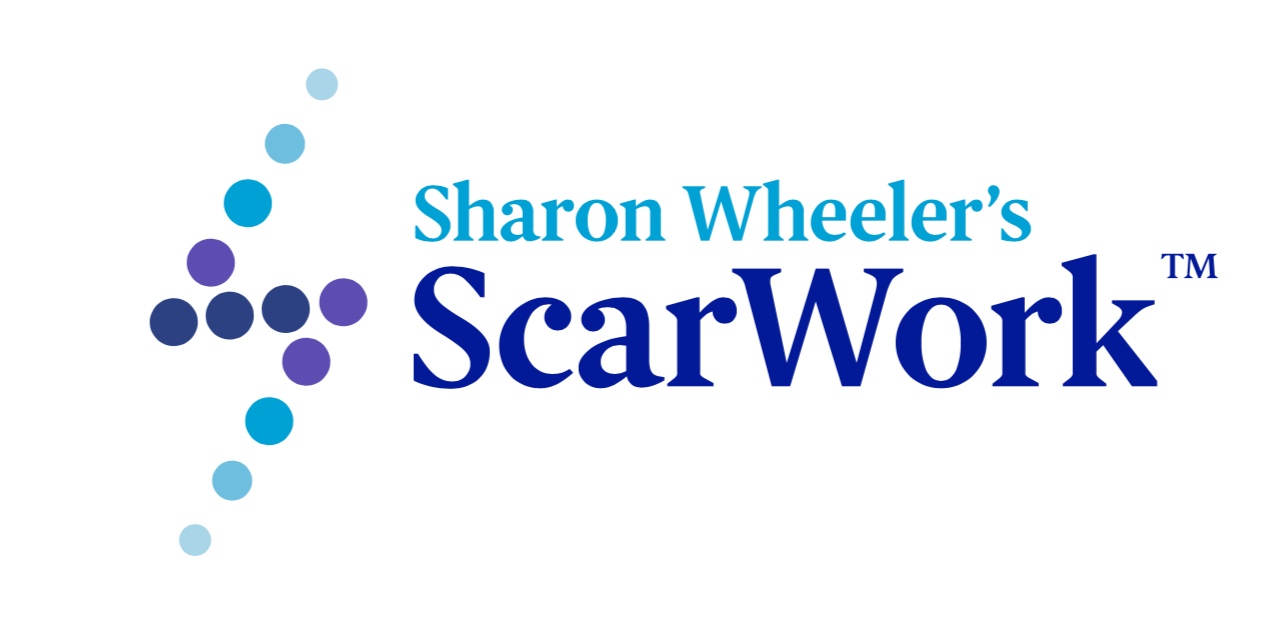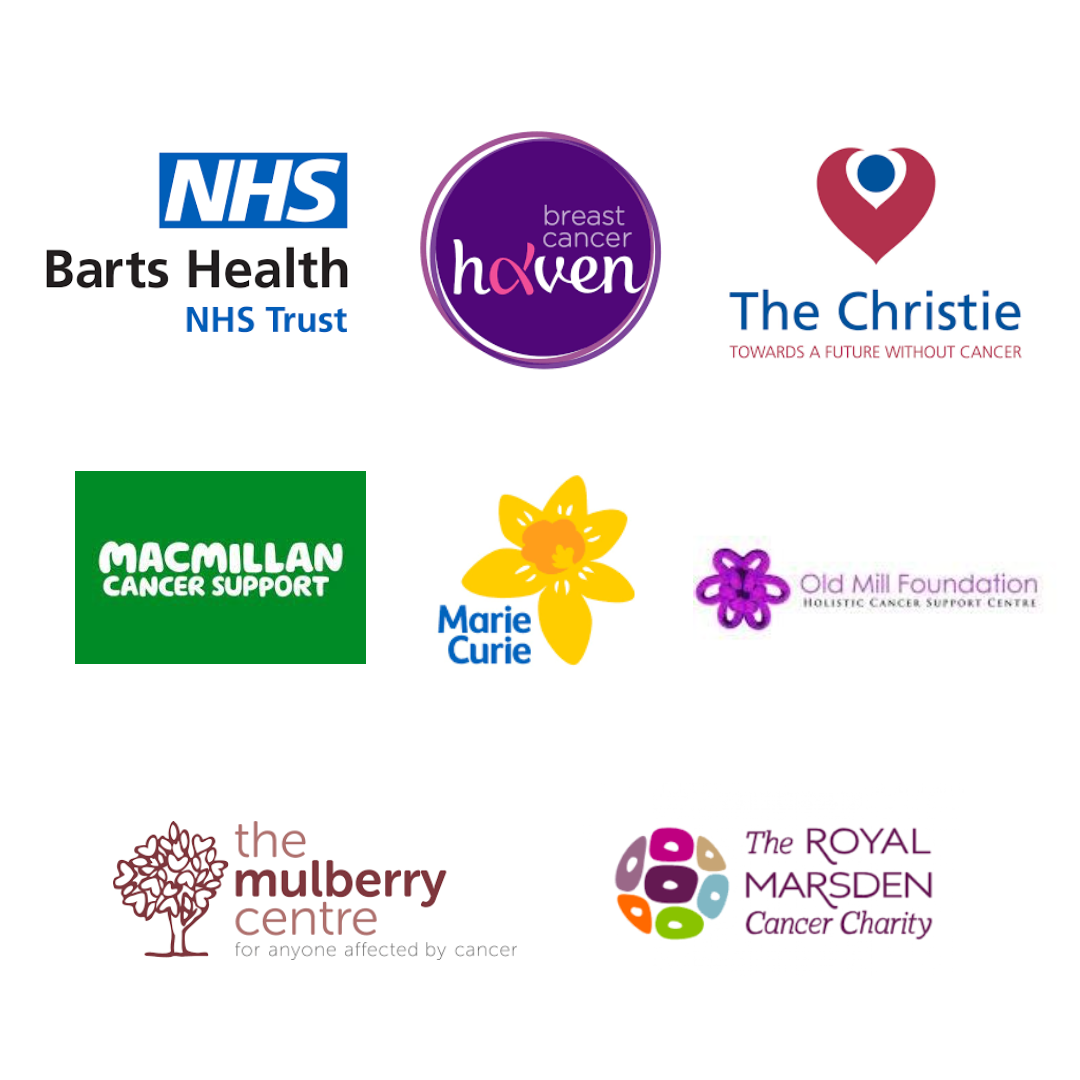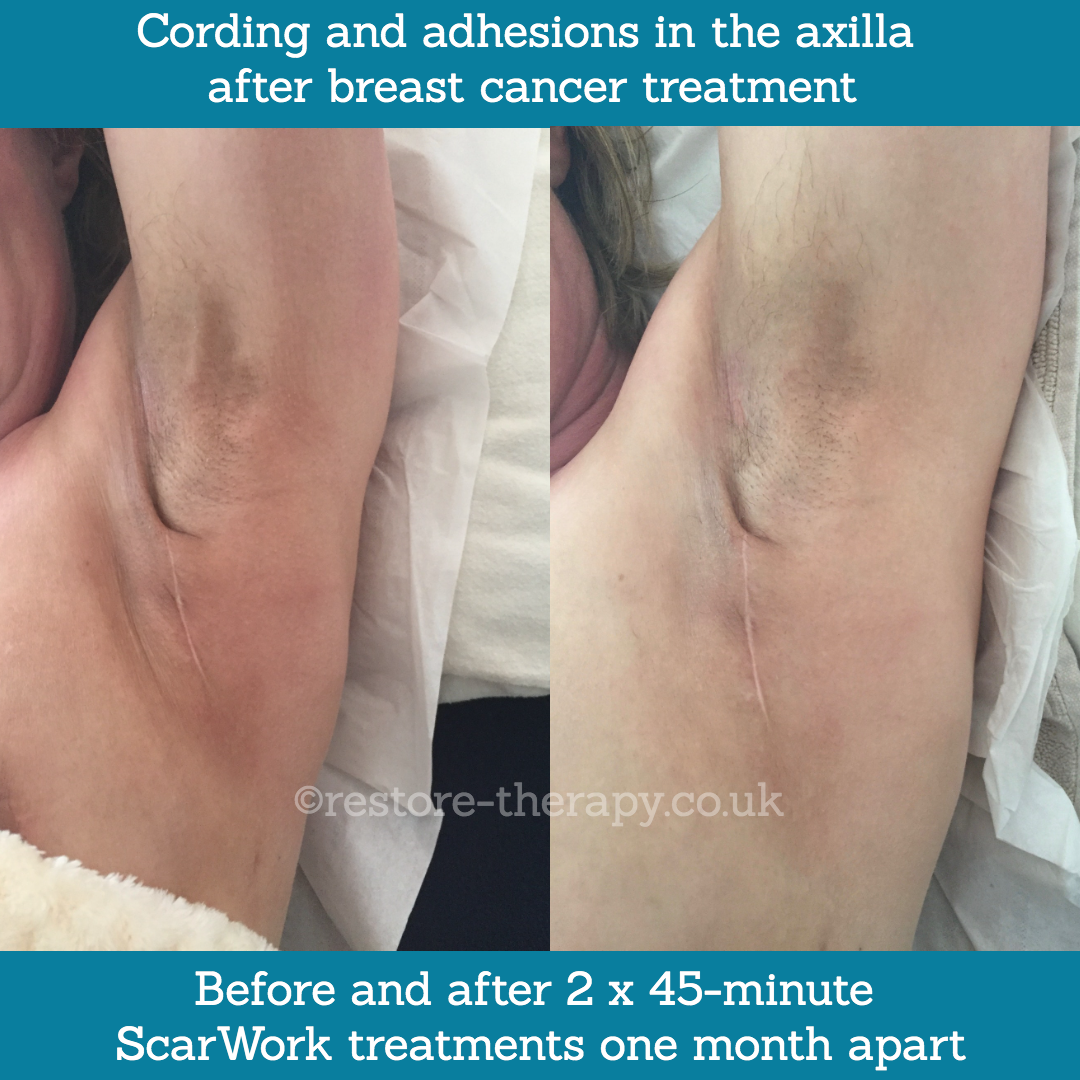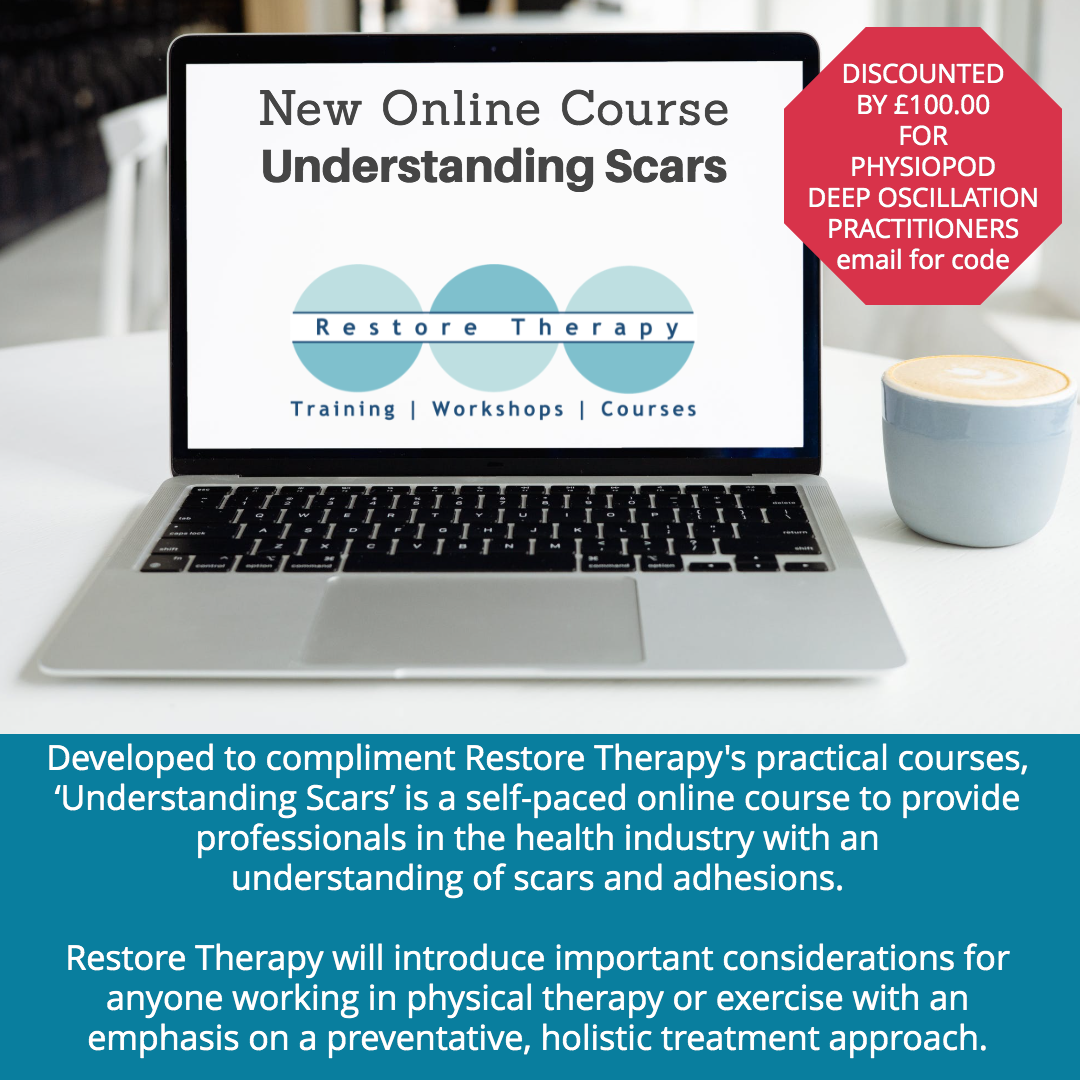Scar Therapy: A Helpful Skill for the Lymphoedema Therapist
When working with Lymphoedema, scar therapy may be a very useful skill to incorporate into treatment. Scar tissue or adhesions from surgery or radiotherapy may be one of the factors impeding the lymphatic flow, so incorporating scar therapy techniques may accelerate improvements. A few therapy schools specialise in teaching scar therapy techniques, Emma Holly, founder of Restore Therapy Training, Vice-chair of the ScarWork Committee and Harley Street therapist, shares her knowledge on the benefits of treating scar tissue.
What is Scar Therapy?
‘Scar Therapy’ is the treatment of scars with the aim of improving the health of the tissue. Scar Therapy is most helpful when treating patients with dysfunctional or problematic scar formation. Scar tissue that forms following a surgery or a traumatic accident is different from the pre-injury tissue in its cellular structure and function. If a patient has suffered with infection or necrosis, compromising smooth healing or if the patient receives higher doses of radiotherapy, then the likelihood increases of excessive scar formation, and subsequent discomfort or complications linked to the scar.
Scar tissue, fibrosis and adhesions are terms to describe the internal complications that can occur after surgery. Externally there are not always visual abnormalities on the superficial scar line to indicate a dysfunctional scar. Symptoms of dysfunctional scars may include pain, sensitivity, oedema, reduction in flexibility, palpable bulky fibrous tissue and scar adhesions.
In addition to creating a physical problem, there are often psychological implications after surgery or trauma leaves a scar. The patient may feel self-conscious or unhappy about their appearance, in some cases the patient describes that area of their body feeling disconnected. This is more common if the scar remains numb, painful or has altered sensation. A dislike of touch means many people may never have touched their scar. Scar treatment can be a helpful non-medicalised therapeutic touch to promote healing emotionally as well as physically. Available literature on Scar Therapy states:
“Massage can help soften and de-sensitize scars. When combined with stretching, massage can make the scar looser, softer and more comfortable.[i]”
“There is growing evidence that scar massage leads to clinically relevant improvement not only of pain, itching and pliability of scars, but also of mood and anxiety of patients[ii]”
A variety of Scar Therapy approaches are available utilising manual treatment or machines to promote softening of the fibrosis and to stimulate tissue repair. Each approach may differ slightly in its technique and application. Therapists are now embracing utilising a gentle approach in scar treatment, as more aggressive scar manipulation can be very uncomfortable for the patient and may cause inflammation or irritation. Patients with Lymphoedema, or at high risk of Lymphoedema, are better suited to a gentle approach which is less likely to overload their system. ScarWork is a discipline of scar therapy, rapidly growing in popularity since training was introduced to the UK in 2014 by the originator of the techniques, Sharon Wheeler. ScarWork can be used as a stand-alone therapy, or used to compliment treatment with a device such as Deep Oscillation.

ScarWork, also known as Sharon Wheeler’s ScarWork, is a light touch treatment for new and old scars. ScarWork Therapists benefit from being represented by the ScarWork Committee, a voluntary organisation set up support and promote its members and fund research. Funds raised by the committee are facilitating a project led by Dr Beverley de Valois, a Researcher in Integrative Medicine in the Supportive Oncology Research Team (SORT) at Mount Vernon Cancer Centre. The project will be investigating ScarWork and its application within cancer care.
There is increasing interest in the application of ScarWork to benefit cancer patients, because radiotherapy and fascial damage makes this cohort of patients more likely to suffer with scar tissue complications. Therapists from many cancer support centres have completed training with Restore Therapy including:

ScarWork treatment is focused on the underlying scar tissue so often a visual change will not be observed. Treating symptoms such as discomfort, limited range of movement or areas with thick fibrous scar tissue may be goals agreed between the therapist and patient. Improvement to scar adhesions can create a change in appearance, so observable changes may be possible as seen in the example of this lady with cording and adhesions in the axilla after breast cancer. This patient had 2 x 45-minute treatments one month apart.

The techniques of ScarWork were developed and refined over the last 45 years by American therapist Sharon Wheeler. Treatments are used to generate improvement in a scar and the underlying tissue. Any changes are a response to the stimulation delivered via direct touch applied by the therapist. Ultrasounds taken before and after ScarWork treatment have shown restoration to fascial tissue[iii].
The ScarWork therapist learns more than 20 techniques, including stroking, pumping, stretching, vibrational and mobilising movements. Treatment starts very gently and progresses deeper as the area softens and releases - the therapists hands flowing in rhythmical movements. During each treatment the therapist will choose which techniques are most appropriate. The sequence of movements is not scripted, and freedom is essential as each scar is individual. A technique may be repeated whilst it is promoting the required response, then changed as the therapist determines an alternative action is required. Sharon Wheeler says:
“I work with the intention of putting the scar back together, reversing the damage, mending the tissue, and reassembling any misaligned, surgically created layers.[iv]”
This gentle approach is paramount. By avoiding or minimising further inflammation, scar tissue production should not return to the same level as immediately post-injury/surgery. This means that changes achieved through treatment should be lasting. I find as a therapist, creating these life changing improvements is hugely rewarding. Sophie Lindsey shares her experience of a single treatment at Restore Therapy:
“Today I had ScarWork therapy on my 4 year old C-Section scar…It was incredible, the results were instant, my scar looked and felt better on the surface. Deeper down I have struggled with issues to my right side, I hadn’t realised how much mobility I had lost and how much pain I was coping with until now. My goodness, I can bend at my waist completely in jeans without any pain, I can lay on my front, even arch my back up, no pain. And I just sneezed and didn’t have to hold onto my stomach to reduce the pain.”
About Emma Holly

Emma Holly has been a therapist since 1993. She began specialising in scar tissue and ScarWork in 2015 and became a teacher in 2017. Emma has introduced ScarWork within Macmillan Cancer Support, Invictus Games via Help for Heroes, British Athletics, NHS, HCA and Spire Hospitals.
BOOK NOW for Emma Holly's new online course 'Understanding Scars' which compliments her hands-on courses, or as a stand-alone course to provide information on supporting recovery after surgery or trauma.
Website www.restoretherapy.co.uk email emma.holly@restoretherapy.co.uk
[i] Model Systems Knowledge Translation Center MSKTC (2011) Wound care and scar management after burn injury. Burns factsheet https://msktc.org/burn/factsheets/Scar-Management
[ii] The Scar Book Formation, Mitigation, Rehabilitation and Prevention. Andrew C Krakowski MD and Peter R Schumaker MD. Wolters Kluwer publishers, page 126
[iii] Scars Adhesions and the Biotensegral Body: Science Assessment and Treatment, Jan Trewartha and Sharon Wheeler Handstring Publishing, Pages 116-118
[iv] Scars Adhesions and the Biotensegral Body: Science Assessment and Treatment. Jan Trewartha and Sharon Wheeler Handstring Publishing, Handstring Publishing, page 118


